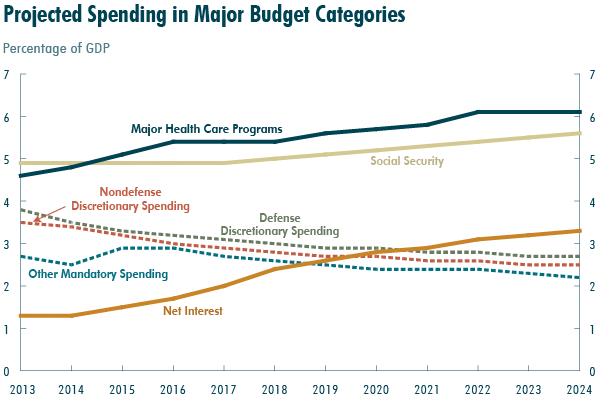In The Budget and Economic Outlook: 2014 to 2024, CBO projects that deficits under current law will decline through 2015, but start rising thereafter—both in dollar terms and relative to the size of the economy—because revenues are expected to grow at roughly the same pace as gross domestic product (GDP) whereas spending is expected to grow more rapidly than the economy. That growth in spending is driven by a few large benefit programs and by the rising costs of interest on the government’s debt.
Federal Spending Is Projected to Grow by 2.6 Percent in 2014
Federal outlays are expected to increase by 2.6 percent this year, to $3.5 trillion, or 20.5 percent of GDP—their average percentage over the past 40 years. That percentage would be less than last year’s total of 20.8 percent and smaller than it has been in any year since 2008.
Mandatory spending, which is generally governed by statutory criteria and is not normally constrained by the annual appropriation process, makes up about 60 percent of the federal budget and accounts for most of the increase in outlays: Such spending is projected to rise by about $85 billion, or 4 percent, to $2.1 trillion this year. Mandatory spending includes outlays for benefit programs, like Social Security, Medicare, and Medicaid, as well as certain other payments to people, businesses, nonprofit institutions, and state and local governments.
In contrast, discretionary spending—which is controlled by annual appropriation acts and accounts for about one-third of the budget—totaled $1.2 trillion in 2013 and is projected to edge down by $7 billion, or less than 1 percent, in 2014. Payments for net interest are expected to rise by $12 billion this year, to $233 billion.
Higher Spending for a Few Major Programs and for Interest on the Public Debt Drives Projected Growth Over the Next Decade
In CBO’s baseline projections—which incorporate the assumption that current laws generally remain the same—total annual outlays rise by $2.5 trillion from 2014 to 2024, reaching $6.0 trillion, or 22.4 percent of GDP, by the end of that period. The 1.8 percentage-point increase over the share projected for 2014 reflects growth in spending for Social Security, major health care programs, and net interest, and a decline (relative to GDP) in other mandatory outlays and discretionary spending (see the figure below). In fact, net federal spending for Social Security and the major health care programs is projected to rise by $1.5 trillion, from $1.7 trillion to $3.2 trillion from 2014 to 2024—accounting for 60 percent of the total projected increase in federal spending over that period. By 2024, spending for those programs will represent more than half of the federal budget and will equal 11.7 percent of GDP.

Specifically, under current law, federal spending in the following areas is projected to grow as a share of GDP over the coming decade:
- Social Security—Outlays for the largest federal program are projected to rise from 4.9 percent of GDP in 2014 to 5.6 percent in 2024, as the retirement of the baby boomers helps boost the number of people collecting Social Security benefits by one-third.
- Major health care programs—Outlays for Medicare, Medicaid, the Children’s Health Insurance Program, and subsidies offered through health insurance exchanges are projected to increase more rapidly than outlays for Social Security, from 4.8 percent of GDP in 2014 to 6.1 percent in 2024, net of premium income and other offsetting receipts related to Medicare. (Offsetting receipts are certain collections by the government that are recorded as offsets to spending, rather than as revenues.) That increase is driven by the growing number of retirees, the expansion of federal subsidies for health insurance, and rising health care spending per beneficiary.
- Net interest—The government’s net interest costs are projected to increase rapidly, by an average of roughly 14 percent per year, almost quadrupling in dollar terms between 2014 and 2024, as interest rates return to more typical levels and federal debt continues to mount. As a share of GDP, they are projected to rise from 1.3 percent in 2014 to 3.3 percent in 2024.
Other spending is projected to grow more slowly than the economy and thus to decline relative to GDP under current law:
- All other mandatory programs—Spending for the rest of mandatory programs (net of other offsetting receipts) are expected to decline from 2.5 percent of GDP in 2014 to 2.2 percent in 2024 because per-beneficiary spending for many of those programs grows with inflation (which is projected to increase more slowly than the overall economy) and because the number of beneficiaries of some of those programs is expected to drop as the economy improves.
- Discretionary spending—Largely because appropriations are constrained through 2021 by the caps that were originally established by the Budget Control Act of 2011 (with some subsequent modifications), both defense and nondefense discretionary outlays are projected to fall by more than 20 percent relative to the size of the economy over the next 10 years. Total discretionary outlays are projected to drop from 6.9 percent of GDP in 2014 to 5.2 percent in 2024.
Christi Hawley Anthony, Jared Brewster, Amber Marcellino, and Santiago Vallinas are analysts in CBO’s Budget Analysis Division.

